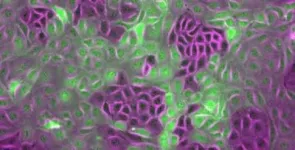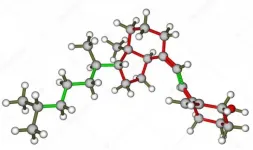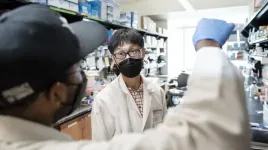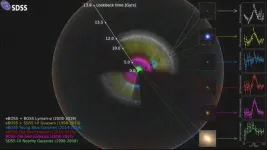Force transmission between cells orchestrates collective cellular motion
2021-04-23
(Press-News.org) How do the billions of cells communicate in order to perform tasks? The cells exert force on their environment through movement - and in doing so, they communicate. They work as a group in order to infiltrate their environment, perform wound healing and the like. They sense the stiffness or softness of their surroundings and this helps them connect and organize their collective effort. But when the connection between cells is distrubeddisturbed, a situation just like when cancer is initiated, can appear.
Assistant Professor Amin Doostmohammadi at the Niels Bohr Institute, University of Copenhagen has investigated the mechanics of cell movement and connection in an interdisciplinary project, collaborating with biophysicists in France, Australia, and Singapore, using both computer modelling and biological experiments. The result is now published in Nature Materials.
Amin Doostmohammadi explains: "We need to understand how cells translate this "knowledge from sensing" at the individual cell level and transform it into action on the collective level. This is still kind of a black box in biology - how do cell talk to their neighbors and act as a collective?"
The force of surrounding tissue dictates cell behavior
Individual cells have a contractile mode of motion: they pull on the surface they are located on to move themselves forward. However, cells lining up cavities and surfaces in our body, like the tubes of blood vessels or the cells at the surface of organs, are able to generate extensile forces. They do the opposite, they stretch instead of contract - and they form strong connections with their neighbors. Contractile cells are able to switch to becoming extensile cells, when coming into contact with their neighbors. If, for instance, when contractile cells sense a void or an empty space, like when a wound appears, they can loosen their cell - cell connection, become more individual, and when healing the wound, they form strong connections with their neighbors again, becoming extensile, closing the gap, so to speak.
Weakening cell connection can be the hallmark of cancer initiation
The cells connect to their neighbors by adherens junctions. They connect their internal cytoskeleton to one another and become able to transmit forces through the strong contacts. "So we asked ourselves what would happen if we prohibited the cells from making this strong connection - and it turned out that extensile, strongly connected cells turned into contractile cells with weaker connections. This is significant, because the loss of this contact is the hallmark of cancer initiation. The cells losing contact start behaving more as individuals and become able to infiltrate their surroundings. This process also happens when an embryo develops, but the key difference here is that when the healthy cells have achieved their goal, like forming an organ, they go back to their original form. Cancer cells do not. They are on a one way street", Amin Doostmohammadi says.
The basic action and reaction of cells are determined by surroundings and communication
How cells "decide" when to go from one form to another is a complicated mix of reacting to their environment, changes in the chemical composition of it, the mechanical stiffness or softness of the tissue - and many proteins in the cells are involved in the process. The key finding of this study is that this reaction to surroundings is constantly shifting: There is a constant cross-talk between cell - surroundings and cell - cell, and this is what determines the actions and reactions of the cells.
Are treatments for cancer within the scope of this new understanding in cell mechanics?
"We must always be careful, when talking about a serious and very complex disease like cancer", Amin Doostmohammadi says. "But what we can say is that this study brings us one step closer to understanding the basic mechanics of cell behavior, when the cells go from the normal behavior to the aggressive, cancer type cell behavior. So, one of the big questions this study raises is if we might be able to target the mechanics of the cells by some form of therapy or treatment, instead of targeting the DNA or chemical composition of the cells themselves? Could we target the environment instead of the cells? This is basic research, connecting physics and biology, into the mechanics of cell behavior, based on their sensing and responding to the surroundings and coordinating their effort - our improved understanding of this may well lead to new therapies, and there are trials going on at the moment at a preliminary stage".
INFORMATION:
[Attachments] See images for this press release:

ELSE PRESS RELEASES FROM THIS DATE:
2021-04-23
Etrasimod 2 mg treatment group achieved statistical significance in the percentage change in weekly peak pruritis (PP-NRS), in the change in Dermatology Life Quality Index (DLQI), and in the change in Patient-Oriented Eczema Measure (POEM)
Etrasimod 2 mg was generally well tolerated, consistent with data in previous trials
Park City, Utah, April 23, 2021 - Arena Pharmaceuticals, Inc. (Nasdaq: ARNA) today announced data at a late-breaking session at the American Academy of Dermatology VMX Experience. Etrasimod, a novel investigational drug candidate to treat moderate-to-severe atopic dermatitis (AD), demonstrated statistical significance in both clinician and patient reported outcomes in the ADVISE Phase 2b clinical trial. Etrasimod is a highly selective, once-daily, oral sphingosine ...
2021-04-23
Paper Title: Safety of Tranexamic Acid in Hip and Knee Arthroplasty in High-risk Patients
Journal: Anesthesiology
Authors: Jashvant Poeran MD, PhD, Director of the Center for Clinical and Outcomes Research, and Associate Professor of Population Health Science & Policy and Orthopedics at the Icahn School of Medicine at Mount Sinai; Calin S. Moucha, MD, Chief of Adult Reconstruction & Joint Replacement Surgery at Mount Sinai Hospital, and Associate Professor of Orthopedics at the Icahn School of Medicine at Mount Sinai; and other coauthors.
Bottom Line: The use of the drug tranexamic acid is commonplace in patients undergoing hip or knee replacement surgery to reduce blood loss. However, this drug works by promoting clotting and safety concerns exist when used in certain high-risk ...
2021-04-23
By Karina Toledo | Agência FAPESP – Can a high dose of vitamin D administered on admission to hospital improve the condition of patients with moderate or severe COVID-19? The answer is no, according to a Brazilian study published in the Journal of the American Medical Association (JAMA).
The article reports a randomized, double-blind, placebo-controlled clinical trial, the kind of study considered the gold standard to evaluate drug efficacy. It was conducted with FAPESP’s support by researchers at the University of São Paulo’s ...
2021-04-23
DURHAM, N.H.-- Corals and sponges are important foundations in ocean ecosystems providing structure and habitats that shelter a high number of species like fish, crabs and other creatures, particularly in the seamounts and canyons of the deep sea. Researchers at the University of New Hampshire have discovered that when it comes to climate change not all deep-sea corals and sponges are affected the same and some could be threatened if average ocean temperatures continue to increase in the deep sea of the Northwest Atlantic.
"These deep-sea corals and sponges are ecologically important because they are foundational ...
2021-04-23
ITHACA, N.Y. - House finches are locked in a deadly cycle of immunity and new strains of bacterial infection in battling an eye disease that halved their population when it first emerged 25 years ago, according to new research from the Cornell Lab of Ornithology.
House finch eye disease causes red, swollen, watery or crusty eyes. Afflicted birds can recover, but may die because they cannot see well enough to find food or avoid predators. The latest analyses, based on the observations of Project FeederWatch participants from eight Northeast states, addresses the long-term ...
2021-04-23
A recently published article in the Molecular Plant-Microbe Interactions journal provides new evidence that pathogens are hijacking the plant immune system to cause disease while providing insights into a newly discovered mechanism.
A large variety of pathogens infect plants and cause different diseases, which can lead to reduced crop yields. During infection, pathogens secrete effector proteins into the plant cell. Some of these proteins target plant proteasomal degradation machinery, which is responsible for recycling proteins to regulate cell processes. Some E1, E2 and E3-ligase proteins have been identified as playing a role in plant susceptibility ...
2021-04-23
PHILADELPHIA, PA - The first National Institutes of Health (NIH) National Cancer Institute (NCI)-funded clinical study examining stereotactic body radiotherapy (SBRT) in the treatment of oligometastatic breast, prostate, and non-small cell lung (NSCLC) cancers displayed evidence that SBRT can be safely used to treat patients who have multiple metastases. These results were recently published in JAMA Oncology.
The results of the Phase I NRG-BR001 trial, conducted by the NCI National Clinical Trials Network group NRG Oncology, indicate that SBRT treatment in ...
2021-04-23
SAN FRANCISCO, CA--April 22, 2021--In their effort to understand the very earliest stages of life and how they can go wrong, scientists are confronted with ethical issues surrounding the use of human embryos. The use of animal embryos is also subject to restrictions rooted in ethical considerations. To overcome these limitations, scientists have been trying to recreate early embryos using stem cells.
One of the challenges in creating these so-called synthetic embryos is to generate all the cell types normally found in a young embryo before it implants into the wall of the uterus. Some of these cells eventually give rise to the placenta. Others become the amniotic sac in which the fetus grows. Both the placenta and the amniotic sac are crucial for the survival of the fetus, and defects ...
2021-04-23
A new research paper examining the relationship between the Omega-3 Index and risk for death from any and all causes has been published in END ...
2021-04-23
The extended Baryon Oscillation Spectroscopic Survey (eBOSS) collaboration has released its latest scientific results. These results include two studies on dark energy led by Prof. ZHAO Gongbo and Prof. WANG Yuting, respectively, from National Astronomical Observatories of the Chinese Academy of Sciences(NAOC).
The study led by Prof. Zhao was recently published in Monthly Notices of the Royal Astronomical Society.
Based on eBOSS observations, Prof. ZHAO's team measured the history of cosmic expansion and structure growth in a huge volume of the past universe, corresponding to a distance range between 0.7 and 1.8 billion light years away from us. This volume had never been ...
LAST 30 PRESS RELEASES:
[Press-News.org] Force transmission between cells orchestrates collective cellular motion



